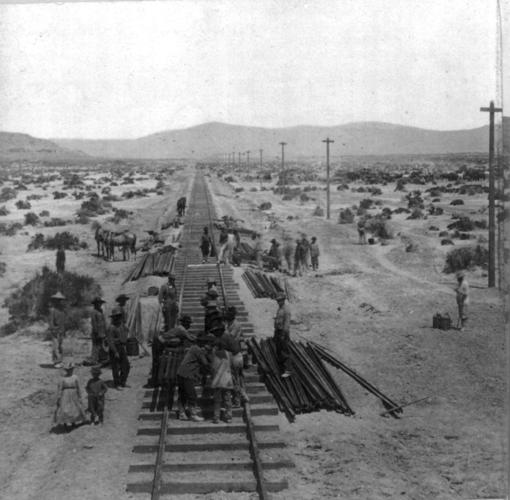For longtime Tucsonan Dennis Tom, the recurring anniversaries of the Transcontinental Railroad’s completion likely didn’t carry much meaning until this year.
But after learning that his late grandfather, Tom Loy, was one of more than 1,000 Chinese railroad workers in Tucson who helped connect the southern part of the track, it brought with it an appreciation for a part of his family’s legacy he never knew.
“To find out a little more about what my grandfather did was interesting,” Dennis Tom said. “I always felt like we were some of the first people there of the Chinese descent, I think there was quite a few others before us, but being there over a hundred years, that puts us in a bracket that not too many people can say.”
As he scoured newspaper archives, he found that his grandfather not only worked on the Southern Pacific Railroad, but he would later settle down in Tucson to open a successful market that helped employ members of the Chinese community. The 150th anniversary of the main railroad connection is being celebrated this year.
Tom Loy first arrived in the U.S. in 1878, after spending about 13 years in what is now Taishan County of Guangdong, China. He was unaware at the time that his boat trip to San Francisco would be a one-way ticket, Dennis Tom learned.
Two years later, his grandfather embarked on a 10-year stay in Tucson, where he worked on the tracks that connected San Francisco to New Orleans.
The conditions in Tucson and elsewhere must have made it tough for the more than 10,000 Chinese workers , according to Howard Eng, who is on the board of directors for the Tucson Chinese Cultural Center.
“There was discrimination, the Chinese workers were not treated very well. In some cases, the Chinese workers had the most dangerous and difficult jobs,” Eng said.
“They were the ones who had to carry the dynamite and eventually they had to carry the nitroglycerin for blasting.”
As a young teen, Tom Loy likely became a water carrier when he arrived, according to Dennis Tom. “Being so young, I think what he did was supply water to all the workers,” he said. “When they got to Tucson, it was a one-way ticket, he didn’t realize, and when they finished the railroad station, they just left him there.”
Tom Loy’s job may have varied during his 10-year stint with the Southern Pacific Transportation Co., which later merged with Union Pacific. And the economic impact of the workers was felt for many years after, especially in Arizona.
“The ranchers that have cattle, they’re able to ship that cattle back east and to California and other parts of the country,” Eng said.
“The mines now had a place to ship their ore to all parts of the country. Then it also provided a way for people to come to Tucson and Arizona City because now you have a transportation system that is pretty consistent and relatively speedy compared to the wagon or stagecoach.”
Tom Loy was also likely present when thousands gathered in Tucson in celebration of the first train arriving in the city on March 20, 1880.
During that celebration, “A cannon was fired and the Sixth Cavalry Band serenaded Southern Pacific Railroad President Charles Crocker, General Superintendent James Gamble of the Western Union Telegraph Company and other dignitaries in celebration of the big day. There were many speeches,” according to Arizona Daily Star archives.
Throughout the 1880s, workers maintained the track, connected it to the eastern line from San Francisco to New York and helped rebuild the track along Cienega Creek near Vail, according to the Tucson Chinese Cultural Center.
It was 1890 when Tom Loy decided to leave the company and start on the path of becoming a successful businessman.
He first opened Tom’s Market on West Simpson Street and South Meyer Avenue, near where the Tucson Convention Center is today. By 1905, he had also operated a hotel in the gold-mining town of Congress, Arizona, before returning.
That same year, Tom Loy reopened the market bearing his name, this time on the corner of North Fourth Avenue and Seventh Street, where steaks were 15 cents per pound, according to an advertisement in the Star.
Dennis Tom said the store offered goods to the community while also employing Chinese workers, whether family or others. It continued even after Loy’s death in 1924.
“Basically, employees of the store were relatives or other Chinese, and I guess most of the time they never got paid, but my grandfather would feed them, clothe them and if they wanted to get an education they would go to school,” Dennis Tom said.
Tom Loy is one of three men that the Chinese Cultural Center has identified as settling in Tucson after working for the railroad. On June 1, there will be an event highlighting their work and that of thousands of others from the Chinese community.
The unveiling of the Pima County Railroad Exhibit at 1288 W. River Road will be from 11 a.m. to 1 p.m.; light refreshments will follow.
With the unveiling, the cultural center’s representatives hope to “show a legacy of Chinese workers and their impact on the railroad,” Eng said.
Down the Road
Motorists eastbound on Interstate 10 between Cortaro and Orange Grove roads should expect lane closures as road crews remove barriers in the area Tuesday night.
The right two lanes of I-10 will be closed from 8 p.m. to 5 a.m. Wednesday.
Motorists should use caution and watch for personnel in the area.





